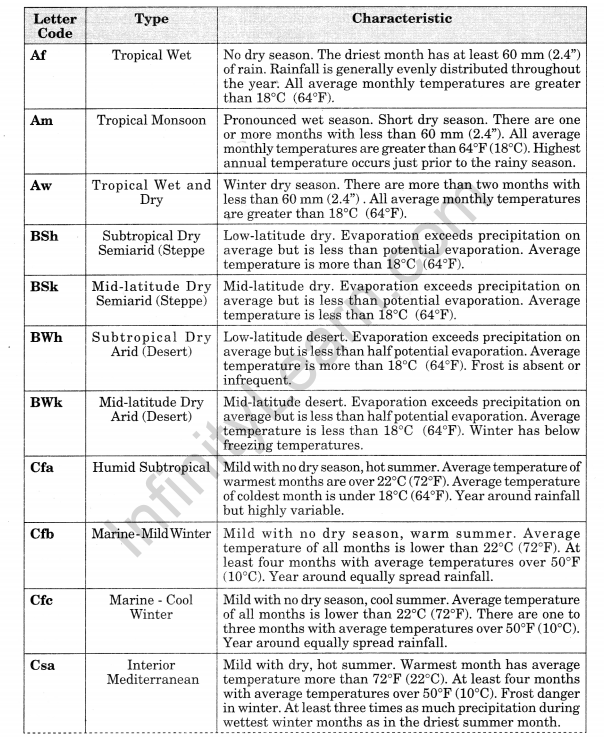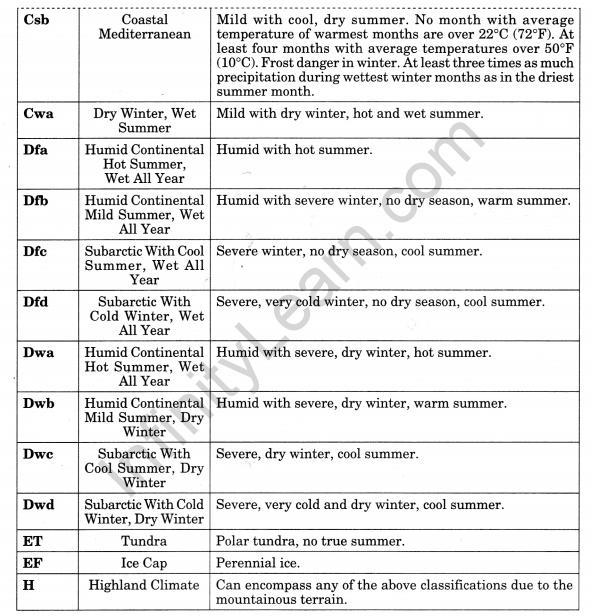Table of Contents
Class 11 Geography Notes Chapter 12 World Climate and Climate Change
Three broad approaches have been adopted for classifying climate. They are empirical, genetic and applied.
Koeppen identified a close relationship between the distribution of vegetation and climate. He selected certain values of temperature and precipitation and related them to the distribution of vegetation and used these values for classifying the climates.
Climatic Groups According to Koeppen:
| Group | Characteristics |
| A – Tropical | Average temperature of the coldest month is 18° C or higher. |
| B – Dry Climates | Potential evaporation exceeds precipitation. |
| C – Warm Temperature | The average temperature of the coldest month of the (Mid-latitude) climates years is higher than minus 3°C but below 18°C. |
| D – Cold Snow Forest Climates | The average temperature of the coldest month is minus 3°C or below. |
| E – Cold Climates | Average temperature for all months is below 10°C. |
| H – High Land | Cold due to elevation. |
Koeppen introduced the use of capital and small letters to designate climatic groups and types.
It was developed in 1918 and modified over a period of time, but Koeppen’s scheme is still popular and in use. Koeppen recognized five major climatic groups, four of them are based on temperature and one on precipitation.
The capital letters: A,C, D and E delineate humid climates and B dry climates. The climatic groups are subdivided into types, designated by small letters, based on seasonality of precipitation and temperature characteristics. The seasons of dryness are indicated by the small letters : f, m, w and s.
Tropical humid climates exist between Tropic of Cancer and Tropic of Capricorn. The sun being overhead throughout the year and the presence of Inter Tropical Convergence Zone (ITCZ) make the climate hot and humid. Annual range of temperature is very low and annual rainfall is high.
The tropical group is divided into three types, namely
- Af – Tropical wet climate;
- Am – Tropical monsoon climate;
- Aw – Tropical wet and dry climate.
Tropical wet climate is found near the equator. The major areas are the Amazon Basin in South America, western equatorial Africa and the islands of East Indies. Significant amount of rainfall occurs in every month of the year as thunder showers in the afternoon.
The temperature is uniformly high and the annual range of temperature is negligible. The maximum temperature on any day is around 30°C while the minimum temperature is around. 20°C. Tropical evergreen forests with dense canopy cover and large biodiversity are found in this climate.
Tropical monsoon climate (Am) is found over the Indian sub-continent, North Eastern part of South America and Northern Australia. Heavy rainfall occurs mostly in summer. Winter is dry.
Climatic Types:


Dry climates are characterized by very low rainfall that is not adequate for the growth of plants. These climates cover a very large area of the planet extending over large latitudes from 15° – 60° north and south of the equator.
Subtropical Steppe (BSh) and Subtropical Desert (BWh) climates have common precipitation and temperature characteristics. These are located in the transition zone between humid and dry climates, subtropical steppe receives slightly more rainfall than the desert, adequate enough for the growth of sparse grasslands.
Maximum temperature in the summer is very high. The highest shade temperature of 58° C was recorded at A1 Aziziyah, Libya on 13 September 1922. The annual and diurnal ranges of temperature are also high.
Mediterranean climate occurs around Mediterranean sea, along the west coast of continents in subtropical latitudes between 30° – 40° latitudes.
Central California, Central Chile, along the coast in south eastern and south western Australia are examples of Mediterranean climate. These areas come under the influence of subtropical high in summer and westerly wind in winter. Hence, the climate is characterised by hot, dry summer and mild, rainy winter. Monthly average temperature in summer is around 25° C and in winter below 10°C. The annual precipitation ranges between 35 – 90 cm.
Humid subtropical climate occur in eastern United States of America, southern and eastern China, southern Japan, north eastern Argentina, coastal south Africa and eastern coast of Australia. The annual average of precipitation vary from 75-150 cm. Thunderstorms in summer and frontal precipitation in winter are common. Mean monthly temperature in summer is around 27°C, and in winter it varies from 5°-12° C. The daily range of temperature is small.
India also witnessed alternate wet and dry periods. Archaeological findings show that the Rajasthan desert experienced wet and cool climate around 8,000 B.C. The period 3,000-1,700 B.C. had higher rainfall. From about 2,000-1,700 B.C., this region was the centre of the Harappan civilisation.
Dry conditions accentuated since then. In the geological past, the earth was warm some 500-300 million years ago, through the Cambrian, Ordovician and Silurian periods. During the Pleistocene epoch, glacial and inter-glacial periods occurred, the last major peak glacial period was about 18,000 years ago. The present inter-glacial period started 10,000 years ago.
The 1990s recorded the warmest temperature of the century and some of the worst floods around the world. The worst devastating drought in the Sahel region, south of the Sahara desert, from 1967-1977 is one such variability.
During the 1930s, severe drought occurred in south-western Great Plains of the United States, described as the dust bowl. Historical records of crop yield or crop failures, of floods and migration of people tell about the effects of changing climate.
Europe witnessed “Little Ice Age” from 1550 to about 1850. From about 1885-1940 world temperature showed an upward trend. After 1940, the rate of increase in temperature slowed down.
The term greenhouse is derived from the analogy to a greenhouse used in cold areas for preserving heat. A greenhouse is made up of glass. The glass which is transparent to incoming short wave solar radiation is opaque to outgoing long wave radiation. The glass, therefore, allows in more radiation and prevents the long wave radiation going outside the glass house, causing the temperature inside the glasshouse structure warmer than outside. When you enter a car or a bus, during summers, where windows are closed, you feel more heat than outside. Likewise during winter the vehicles with closed doors and windows remain warmer than the temperature outside. This is another example of the greenhouse effect.
Greenhouse gases are carbon dioxide (C02), Chlorofluorocarbons (CFCs), methane (CH4), nitrous oxide (N20) and ozone (03). Some other gases such as nitric oxide (NO) and carbon monoxide (CO) easily react with GHGs and affect their concentration in the atmosphere.
The largest concentration of GHGs in the atmosphere is carbon dioxide. The emission of C02 comes mainly from fossil fuel combustion (oil, gas and coal).
Ozone occurs in the stratosphere where ultra-violet rays convert oxygen into ozone. Thus, ultra violet rays do not reach the earth’s surface. The CFCs which drift into the stratosphere destroy the ozone. Large depletion of ozone occurs over Antarctica. The depletion of ozone concentration in the stratosphere is called the ozone hole.
International efforts have been initiated for reducing the emission of GHGs into the atmosphere. The most important one is the Kyoto protocol proclaimed in 1997.
Class 11 Geography Notes Chapter 12 Important Terms:
- Empirical Classification: It is based on observed data, particularly on temperature and precipitation.
- Genetic Classification: It attempts to organise climates according to their causes.
- Applied Classification: It is used when classification is done for specific purpose.
- Koeppen’s scheme of classification of climate: It is the most widely used classification of climate is the empirical climate classification scheme developed by V. Koeppen. Koeppen identified a close relationship between the distribution of vegetation and climate. He selected certain values of temperature and precipitation and related them to the distribution of vegetation and used these values for classifying the climates.
- Ozone Hole: The depletion of ozone concentration in the stratosphere is called the ozone hole.
- Greenhouse gases: The gases that absorb long wave radiation are called greenhouse gases.
- Greenhouse effect: The processes that warm the atmosphere are often collectively referred to as the greenhouse effect.
- Daily range of temperature: The differences between the highest and lowest temperature of a place in a day is called daily range of temperature.
- Dust bowl: During the 1930’s, severe drought occurred in southwestern Great Plains of the United States. These are described as the dust bowl.
- Greenhouse: The term greenhouse is derived from the analogy to a greenhouse used in cold areas for preserving heat. A greenhouse is made up of glass. The glass which is transparent to incoming short wave solar radiation is opaque to outgoing long wave radiation.
- Sunspots: Sunspots are dark and cooler patches on the sun which increase and decrease in a cyclical manner.

